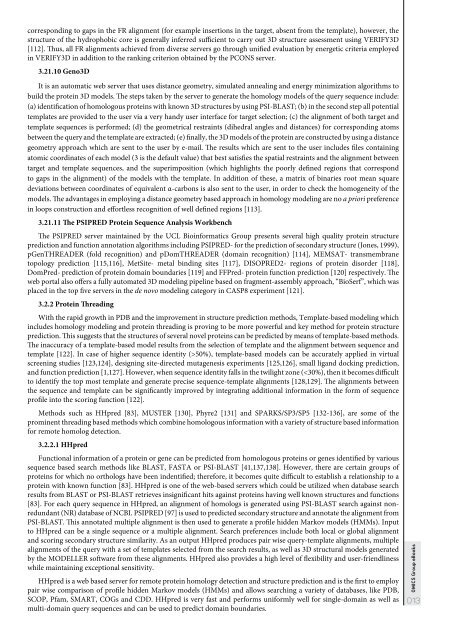Create successful ePaper yourself
Turn your PDF publications into a flip-book with our unique Google optimized e-Paper software.
correspond<strong>in</strong>g to gaps <strong>in</strong> the FR alignment (for example <strong>in</strong>sertions <strong>in</strong> the target, absent from the template), however, the<br />
structure of the hydrophobic core is generally <strong>in</strong>ferred sufficient to carry out 3D structure assessment us<strong>in</strong>g VERIFY3D<br />
[112]. Thus, all FR alignments achieved from diverse servers go through unified evaluation by energetic criteria employed<br />
<strong>in</strong> VERIFY3D <strong>in</strong> addition to the rank<strong>in</strong>g criterion obta<strong>in</strong>ed by the PCONS server.<br />
3.21.10 Geno3D<br />
It is an automatic web server that uses distance geometry, simulated anneal<strong>in</strong>g and energy m<strong>in</strong>imization algorithms to<br />
build the prote<strong>in</strong> 3D models. The steps taken by the server to generate the homology models of the query sequence <strong>in</strong>clude:<br />
(a) identification of homologous prote<strong>in</strong>s with known 3D structures by us<strong>in</strong>g PSI-BLAST; (b) <strong>in</strong> the second step all potential<br />
templates are provided to the user via a very handy user <strong>in</strong>terface for target selection; (c) the alignment of both target and<br />
template sequences is performed; (d) the geometrical restra<strong>in</strong>ts (dihedral angles and distances) for correspond<strong>in</strong>g atoms<br />
between the query and the template are extracted; (e) f<strong>in</strong>ally, the 3D models of the prote<strong>in</strong> are constructed by us<strong>in</strong>g a distance<br />
geometry approach which are sent to the user by e-mail. The results which are sent to the user <strong>in</strong>cludes files conta<strong>in</strong><strong>in</strong>g<br />
atomic coord<strong>in</strong>ates of each model (3 is the default value) that best satisfies the spatial restra<strong>in</strong>ts and the alignment between<br />
target and template sequences, and the superimposition (which highlights the poorly def<strong>in</strong>ed regions that correspond<br />
to gaps <strong>in</strong> the alignment) of the models with the template. In addition of these, a matrix of b<strong>in</strong>aries root mean square<br />
deviations between coord<strong>in</strong>ates of equivalent α-carbons is also sent to the user, <strong>in</strong> order to check the homogeneity of the<br />
models. The advantages <strong>in</strong> employ<strong>in</strong>g a distance geometry based approach <strong>in</strong> homology model<strong>in</strong>g are no a priori preference<br />
<strong>in</strong> loops construction and effortless recognition of well def<strong>in</strong>ed regions [113].<br />
3.21.11 The PSIPRED Prote<strong>in</strong> Sequence Analysis Workbench<br />
The PSIPRED server ma<strong>in</strong>ta<strong>in</strong>ed by the UCL Bio<strong>in</strong>formatics Group presents several high quality prote<strong>in</strong> structure<br />
prediction and function annotation algorithms <strong>in</strong>clud<strong>in</strong>g PSIPRED- for the prediction of secondary structure (Jones, 1999),<br />
pGenTHREADER (fold recognition) and pDomTHREADER (doma<strong>in</strong> recognition) [114], MEMSAT- transmembrane<br />
topology prediction [115,116], MetSite- metal b<strong>in</strong>d<strong>in</strong>g sites [117], DISOPRED2- regions of prote<strong>in</strong> disorder [118],<br />
DomPred- prediction of prote<strong>in</strong> doma<strong>in</strong> boundaries [119] and FFPred- prote<strong>in</strong> function prediction [120] respectively. The<br />
web portal also offers a fully automated 3D model<strong>in</strong>g pipel<strong>in</strong>e based on fragment-assembly approach, “BioSerf”, which was<br />
placed <strong>in</strong> the top five servers <strong>in</strong> the de novo model<strong>in</strong>g category <strong>in</strong> CASP8 experiment [121].<br />
3.2.2 Prote<strong>in</strong> Thread<strong>in</strong>g<br />
With the rapid growth <strong>in</strong> PDB and the improvement <strong>in</strong> structure prediction methods, Template-based model<strong>in</strong>g which<br />
<strong>in</strong>cludes homology model<strong>in</strong>g and prote<strong>in</strong> thread<strong>in</strong>g is prov<strong>in</strong>g to be more powerful and key method for prote<strong>in</strong> structure<br />
prediction. This suggests that the structures of several novel prote<strong>in</strong>s can be predicted by means of template-based methods.<br />
The <strong>in</strong>accuracy of a template-based model results from the selection of template and the alignment between sequence and<br />
template [122]. In case of higher sequence identity (>50%), template-based models can be accurately applied <strong>in</strong> virtual<br />
screen<strong>in</strong>g studies [123,124], design<strong>in</strong>g site-directed mutagenesis experiments [125,126], small ligand dock<strong>in</strong>g prediction,<br />
and function prediction [1,127]. However, when sequence identity falls <strong>in</strong> the twilight zone (



